Remote Sensing of Snow Cover Variability and Its Influence on the Runoff of Sápmi’s Rivers
Abstract
:1. Introduction
2. Materials and Methods
2.1. Snow Cover
2.2. Hydrology
2.3. Meteorology
2.4. Statistical Analysis
2.5. Snowmelt Runoff Model
3. Results
3.1. Snow Cover
3.2. Hydrology
3.3. Meteorology
3.4. Statistics
3.5. Snowmelt Runoff Model
4. Discussion
5. Conclusions
Author Contributions
Funding
Institutional Review Board Statement
Informed Consent Statement
Data Availability Statement
Acknowledgments
Conflicts of Interest
References
- Shi, X.; Marsh, P.; Yang, D. Warming Spring Air Temperatures, but Delayed Spring Streamflow in an Arctic Headwater Basin. Environ. Res. Lett. 2015, 10. [Google Scholar] [CrossRef]
- Yang, D.; Robinson, D.; Zhao, Y.; Estilow, T.; Ye, B. Streamflow Response to Seasonal Snow Cover Extent Changes in Large Siberian Watersheds. J. Geophys. Res. Atmos. 2003, 108. [Google Scholar] [CrossRef]
- Yang, D.; Zhao, Y.; Armstrong, R.; Robinson, D.; Brodzik, M.-J. Streamflow Response to Seasonal Snow Cover Mass Changes over Large Siberian Watersheds. J. Geophys. Res. Earth Surf. 2007, 112. [Google Scholar] [CrossRef] [Green Version]
- Callaghan, T.V.; Johansson, M.; Brown, R.D.; Groisman, P.Y.; Labba, N.; Radionov, V.; Barry, R.G.; Bulygina, O.N.; Essery, R.L.H.; Frolov, D.M.; et al. The Changing Face of Arctic Snow Cover: A Synthesis of Observed and Projected Changes. AMBIO 2011, 40, 17–31. [Google Scholar] [CrossRef] [Green Version]
- Kane, D.L. The Impact of Hydrologic Perturbations on Arctic Ecosystems Induced by Climate Change. In Global Change and Arctic Terrestrial Ecosystems; Oechel, W.C., Callaghan, T.V., Gilmanov, T.G., Holten, J.I., Maxwell, B., Molau, U., Sveinbjörnsson, B., Eds.; Springer: New York, NY, USA, 1997; Volume 124, pp. 63–81. ISBN 978-1-4612-7468-1. [Google Scholar]
- Steiger, R.; Scott, D. Ski Tourism in a Warmer World: Increased Adaptation and Regional Economic Impacts in Austria. Tour. Manag. 2020, 77. [Google Scholar] [CrossRef]
- Spandre, P.; François, H.; Verfaillie, D.; Lafaysse, M.; Déqué, M.; Eckert, N.; George, E.; Morin, S. Climate Controls on Snow Reliability in French Alps Ski Resorts. Sci. Rep. 2019, 9. [Google Scholar] [CrossRef] [PubMed] [Green Version]
- Spandre, P.; François, H.; Verfaillie, D.; Pons, M.; Vernay, M.; Lafaysse, M.; George, E.; Morin, S. Winter Tourism under Climate Change in the Pyrenees and the French Alps: Relevance of Snowmaking as a Technical Adaptation. Cryosphere 2019, 13, 1325–1347. [Google Scholar] [CrossRef] [Green Version]
- Derksen, C.; Brown, R. Spring Snow Cover Extent Reductions in the 2008–2012 Period Exceeding Climate Model Projections. Geophys. Res. Lett. 2012, 39. [Google Scholar] [CrossRef] [Green Version]
- Mudryk, L.R.; Kushner, P.J.; Derksen, C.; Thackeray, C. Snow Cover Response to Temperature in Observational and Climate Model Ensembles. Geophys. Res. Lett. 2017, 44, 919–926. [Google Scholar] [CrossRef]
- Connolly, R.; Connolly, M.; Soon, W.; Legates, D.R.; Cionco, R.G.; Velasco Herrera, V.M. Northern Hemisphere Snow-Cover Trends (1967–2018): A Comparison between Climate Models and Observations. Geosciences 2019, 9, 135. [Google Scholar] [CrossRef] [Green Version]
- Brown, R.D.; Derksen, C. Is Eurasian October Snow Cover Extent Increasing? Environ. Res. Lett. 2013, 8. [Google Scholar] [CrossRef]
- Fontrodona Bach, A.; Schrier, G.; Melsen, L.A.; Klein Tank, A.M.G.; Teuling, A.J. Widespread and Accelerated Decrease of Observed Mean and Extreme Snow Depth Over Europe. Geophys. Res. Lett. 2018, 45, 312–319. [Google Scholar] [CrossRef] [Green Version]
- Berghuijs, W.R.; Harrigan, S.; Molnar, P.; Slater, L.J.; Kirchner, J.W. The Relative Importance of Different Flood-Generating Mechanisms Across Europe. Water Resour. Res. 2019, 2019WR024841. [Google Scholar] [CrossRef] [Green Version]
- ELY Centre. Flood Water Will Rise to the Damage Limit in Rovaniemi and Kittilä in the next Few Days (Lapland). Available online: https://www.ely-keskus.fi/uutiset-2020 (accessed on 28 May 2020).
- Takala, M.; Luojus, K.; Pulliainen, J.; Derksen, C.; Lemmetyinen, J.; Kärnä, J.-P.; Koskinen, J.; Bojkov, B. Estimating Northern Hemisphere Snow Water Equivalent for Climate Research through Assimilation of Space-Borne Radiometer Data and Ground-Based Measurements. Remote Sens. Environ. 2011, 115, 3517–3529. [Google Scholar] [CrossRef]
- Muhammad, S.; Thapa, A. An Improved Terra–Aqua MODIS Snow Cover and Randolph Glacier Inventory 6.0 Combined Product (MOYDGL06*) for High-Mountain Asia between 2002 and 2018. Earth Syst. Sci. Data 2020, 12, 345–356. [Google Scholar] [CrossRef] [Green Version]
- Atif, I.; Iqbal, J.; Mahboob, M.A. Investigating Snow Cover and Hydrometeorological Trends in Contrasting Hydrological Regimes of the Upper Indus Basin. Atmosphere 2018, 9, 162. [Google Scholar] [CrossRef] [Green Version]
- Zhang, H.; Zhang, F.; Zhang, G.; Che, T.; Yan, W.; Ye, M.; Ma, N. Ground-Based Evaluation of MODIS Snow Cover Product V6 across China: Implications for the Selection of NDSI Threshold. Sci. Total Environ. 2019, 651, 2712–2726. [Google Scholar] [CrossRef]
- Pareeth, S.; Delucchi, L.; Metz, M.; Rocchini, D.; Devasthale, A.; Raspaud, M.; Adrian, R.; Salmaso, N.; Neteler, M. New Automated Method to Develop Geometrically Corrected Time Series of Brightness Temperatures from Historical AVHRR LAC Data. Remote Sens. 2016, 8, 169. [Google Scholar] [CrossRef] [Green Version]
- Peters, J.; Bolch, T.; Gafurov, A.; Prechtel, N. Snow Cover Distribution in the Aksu Catchment (Central Tien Shan) 1986-2013 Based on AVHRR and MODIS Data. IEEE J. Sel. Top. Appl. Earth Obs. Remote Sens. 2015, 8, 5361–5375. [Google Scholar] [CrossRef]
- Dietz, J.A.; Conrad, C.; Kuenzer, C.; Gesell, G.; Dech, S. Identifying Changing Snow Cover Characteristics in Central Asia between 1986 and 2014 from Remote Sensing Data. Remote Sens. 2014, 6. [Google Scholar] [CrossRef] [Green Version]
- Dong, C.; Menzel, L. Producing Cloud-Free MODIS Snow Cover Products with Conditional Probability Interpolation and Meteorological Data. Remote Sens. Environ. 2016, 186, 439–451. [Google Scholar] [CrossRef]
- Marchand, N.; Royer, A.; Krinner, G.; Roy, A.; Langlois, A.; Vargel, C. Snow-Covered Soil Temperature Retrieval in Canadian Arctic Permafrost Areas, Using a Land Surface Scheme Informed with Satellite Remote Sensing Data. Remote Sens. 2018, 10, 1703. [Google Scholar] [CrossRef] [Green Version]
- Pan, C.G.; Kirchner, P.B.; Kimball, J.S.; Kim, Y.; Du, J. Rain-on-Snow Events in Alaska, Their Frequency and Distribution from Satellite Observations. Environ. Res. Lett. 2018, 13. [Google Scholar] [CrossRef] [Green Version]
- Marchane, A.; Jarlan, L.; Hanich, L.; Boudhar, A.; Gascoin, S.; Tavernier, A.; Filali, N.; Le Page, M.; Hagolle, O.; Berjamy, B. Assessment of Daily MODIS Snow Cover Products to Monitor Snow Cover Dynamics over the Moroccan Atlas Mountain Range. Remote Sens. Environ. 2015, 160, 72–86. [Google Scholar] [CrossRef]
- Baba, M.W.; Gascoin, S.; Hanich, L. Assimilation of Sentinel-2 Data into a Snowpack Model in the High Atlas of Morocco. Remote Sens. 2018, 10, 1982. [Google Scholar] [CrossRef] [Green Version]
- Metsämäki, S.; Mattila, O.-P.; Pulliainen, J.; Niemi, K.; Luojus, K.; Böttcher, K. An Optical Reflectance Model-Based Method for Fractional Snow Cover Mapping Applicable to Continental Scale. Remote Sens. Environ. 2012, 123, 508–521. [Google Scholar] [CrossRef]
- Dietz, A.J.; Wohner, C.; Kuenzer, C. European Snow Cover Characteristics between 2000 and 2011 Derived from Improved MODIS Daily Snow Cover Products. Remote Sens. 2012, 4. [Google Scholar] [CrossRef] [Green Version]
- Dong, C.; Menzel, L. Snow Process Monitoring in Montane Forests with Time-Lapse Photography. Hydrol. Process. 2017, 31, 2872–2886. [Google Scholar] [CrossRef]
- Dietz, A.J.; Kuenzer, C.; Dech, S. Global SnowPack: A New Set of Snow Cover Parameters for Studying Status and Dynamics of the Planetary Snow Cover Extent. Remote Sens. Lett. 2015, 6, 844–853. [Google Scholar] [CrossRef]
- Court, A. Measures of Streamflow Timing. J. Geophys. Res. (1896-1977) 1962, 67, 4335–4339. [Google Scholar] [CrossRef]
- Burn, D.H. Climatic Influences on Streamflow Timing in the Headwaters of the Mackenzie River Basin. J. Hydrol. 2008, 352, 225–238. [Google Scholar] [CrossRef]
- Martinec, J.; Rango, A.; Major, E. Snowmelt Runoff Model. (SRM) User’s Manual; New Mexico State University: Las Cruces, NM, USA, 2008. [Google Scholar]
- Hall, D.K.; Riggs, G.A.; Salomonson, V.V.; DiGirolamo, N.E.; Bayr, K.J. MODIS Snow-Cover Products. Remote Sens. Environ. 2002, 83, 181–194. [Google Scholar] [CrossRef] [Green Version]
- Hall, D.K.; Riggs, G.A. Normalized-Difference Snow Index (NDSI). In Encyclopedia of Snow, Ice and Glaciers; Singh, V.P., Singh, P., Haritashya, U.K., Eds.; Springer: Dordrecht, The Netherlands, 2011; pp. 779–780. ISBN 978-90-481-2641-5. [Google Scholar]
- Tong, R.; Parajka, J.; Komma, J.; Blöschl, G. Mapping Snow Cover from Daily Collection 6 MODIS Products over Austria. J. Hydrol. 2020, 590. [Google Scholar] [CrossRef]
- Hall, D.K.; Riggs, G.A.; DiGirolamo, N.E.; Román, M.O. MODIS Cloud-Gap Filled Snow-Cover Products: Advantages and Uncertainties. Hydrol. Earth Syst. Sci. Discuss. 2019, 1–23. [Google Scholar] [CrossRef] [Green Version]
- Danielson, J.J.; Gesch, D.B. Global Multi-Resolution Terrain Elevation Data 2010 (GMTED2010); U.S. Department of the Interior, U.S. Geological Survey: Reston, VA, USA, 2011. [Google Scholar]
- Moore, J.N.; Harper, J.T.; Greenwood, M.C. Significance of Trends toward Earlier Snowmelt Runoff, Columbia and Missouri Basin Headwaters, Western United States. Geophys. Res. Lett. 2007, 34. [Google Scholar] [CrossRef] [Green Version]
- Mann, H.B. Nonparametric Tests Against Trend. Econometrica 1945, 13, 245–259. [Google Scholar] [CrossRef]
- Kendall, M.G. A New Measure of Rank Correlation. Biometrika 1938, 30, 81–93. [Google Scholar] [CrossRef]
- Blahušiaková, A.; Matoušková, M.; Jenicek, M.; Ledvinka, O.; Kliment, Z.; Podolinská, J.; Snopková, Z. Snow and Climate Trends and Their Impact on Seasonal Runoff and Hydrological Drought Types in Selected Mountain Catchments in Central Europe. Hydrol. Sci. J. 2020, 1–14. [Google Scholar] [CrossRef]
- Pérez, T.; Mattar, C.; Fuster, R. Decrease in Snow Cover over the Aysén River Catchment in Patagonia, Chile. Water 2018, 10, 619. [Google Scholar] [CrossRef] [Green Version]
- Martinec, J. Snowmelt-Runoff Model for Stream Flow Forecasts. Hydrol. Res. 1975, 6, 145–154. [Google Scholar] [CrossRef]
- Nash, J.E.; Sutcliffe, J.V. River Flow Forecasting through Conceptual Models Part I—A Discussion of Principles. J. Hydrol. 1970, 10, 282–290. [Google Scholar] [CrossRef]
- Boudhar, A.; Hanich, L.; Boulet, G.; Duchemin, B.; Berjamy, B.; Chehbouni, A. Evaluation of the Snowmelt Runoff Model in the Moroccan High Atlas Mountains Using Two Snow-Cover Estimates. Hydrol. Sci. J. 2009, 54, 1094–1113. [Google Scholar] [CrossRef]
- Bouchard, B.; Eeckman, J.; Dedieu, J.-P.; Delclaux, F.; Chevallier, P.; Gascoin, S.; Arnaud, Y. On the Interest of Optical Remote Sensing for Seasonal Snowmelt Parameterization, Applied to the Everest Region (Nepal). Remote Sens. 2019, 11, 2598. [Google Scholar] [CrossRef] [Green Version]
- Morán-Tejeda, E.; Fassnacht, S.R.; Lorenzo-Lacruz, J.; López-Moreno, J.I.; García, C.; Alonso-González, E.; Collados-Lara, A.-J. Hydro-Meteorological Characterization of Major Floods in Spanish Mountain Rivers. Water 2019, 11, 2641. [Google Scholar] [CrossRef] [Green Version]
- De Niet, J.; Finger, D.C.; Bring, A.; Egilson, D.; Gustafsson, D.; Kalantari, Z. Benefits of Combining Satellite-Derived Snow Cover Data and Discharge Data to Calibrate a Glaciated Catchment in Sub-Arctic Iceland. Water 2020, 12, 975. [Google Scholar] [CrossRef] [Green Version]
- Appel, F.; Koch, F.; Rösel, A.; Klug, P.; Henkel, P.; Lamm, M.; Mauser, W.; Bach, H. Advances in Snow Hydrology Using a Combined Approach of GNSS In Situ Stations, Hydrological Modelling and Earth Observation—A Case Study in Canada. Geosciences 2019, 9, 44. [Google Scholar] [CrossRef] [Green Version]
- Li, D.; Lettenmaier, D.P.; Margulis, S.A.; Andreadis, K. The Role of Rain-on-Snow in Flooding Over the Conterminous United States. Water Resour. Res. 2019, 55, 8492–8513. [Google Scholar] [CrossRef] [Green Version]
- Riseth, J.Å.; Tømmervik, H.; Helander-Renvall, E.; Labba, N.; Johansson, C.; Malnes, E.; Bjerke, J.W.; Jonsson, C.; Pohjola, V.; Sarri, L.-E.; et al. Sámi Traditional Ecological Knowledge as a Guide to Science: Snow, Ice and Reindeer Pasture Facing Climate Change. Polar Rec. 2011, 47, 202–217. [Google Scholar] [CrossRef]
- Chen, D.; Rodhe, H.; Emanuel, K.; Seneviratne, S.I.; Zhai, P.; Allard, B.; Berg, P.; Björck, S.; Brown, I.A.; Bärring, L.; et al. Summary of a Workshop on Extreme Weather Events in a Warming World Organized by the Royal Swedish Academy of Sciences. Tellus B Chem. Phys. Meteorol. 2020, 72, 1–13. [Google Scholar] [CrossRef]
- Dankers, R.; Christensen, O.B. Climate Change Impact on Snow Coverage, Evaporation and River Discharge in the Sub-Arctic Tana Basin, Northern Fennoscandia. Clim. Chang. 2005, 69, 367–392. [Google Scholar] [CrossRef]
- Trenberth, K.E. The Impact of Climate Change and Variability on Heavy Precipitation, Floods, and Droughts. In Encyclopedia of Hydrological Sciences; American Cancer Society: Atlanta, GA, USA, 2008; ISBN 978-0-470-84894-4. [Google Scholar]
- Han, P.; Long, D.; Han, Z.; Du, M.; Dai, L.; Hao, X. Improved Understanding of Snowmelt Runoff from the Headwaters of China’s Yangtze River Using Remotely Sensed Snow Products and Hydrological Modeling. Remote Sens. Environ. 2019, 224, 44–59. [Google Scholar] [CrossRef]
- Pangali Sharma, T.P.; Zhang, J.; Khanal, N.R.; Prodhan, F.A.; Paudel, B.; Shi, L.; Nepal, N. Assimilation of Snowmelt Runoff Model (SRM) Using Satellite Remote Sensing Data in Budhi Gandaki River Basin, Nepal. Remote Sens. 2020, 12, 1951. [Google Scholar] [CrossRef]
- Adnan, M.; Nabi, G.; Saleem Poomee, M.; Ashraf, A. Snowmelt Runoff Prediction under Changing Climate in the Himalayan Cryosphere: A Case of Gilgit River Basin. Geosci. Front. 2017, 8, 941–949. [Google Scholar] [CrossRef] [Green Version]
- Varade, D.; Maurya, A.K.; Dikshit, O.; Singh, G.; Manickam, S. Snow Depth in Dhundi: An Estimate Based on Weighted Bias Corrected Differential Phase Observations of Dual Polarimetric Bi-Temporal Sentinel-1 Data. Int. J. Remote Sens. 2020, 41, 3031–3053. [Google Scholar] [CrossRef]
- DLR-EOC. TIMELINE (TIMe Series Processing of Medium Resolution Earth Observation Data assessing Long -Term Dynamics In our Natural Environment). Available online: https://www.dlr.de/eoc/en/desktopdefault.aspx/tabid-9035/15754_read-38904/ (accessed on 26 February 2021).
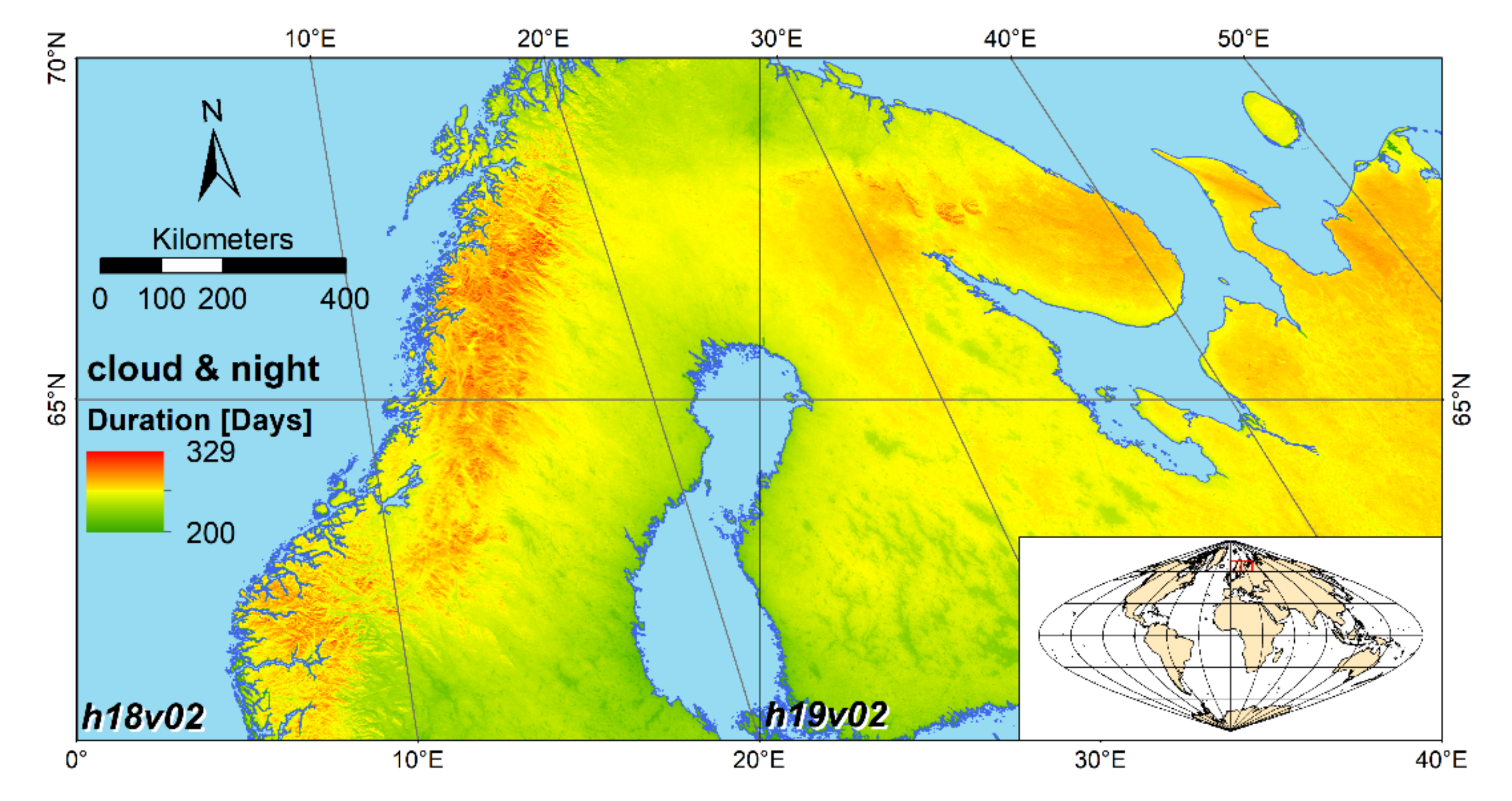
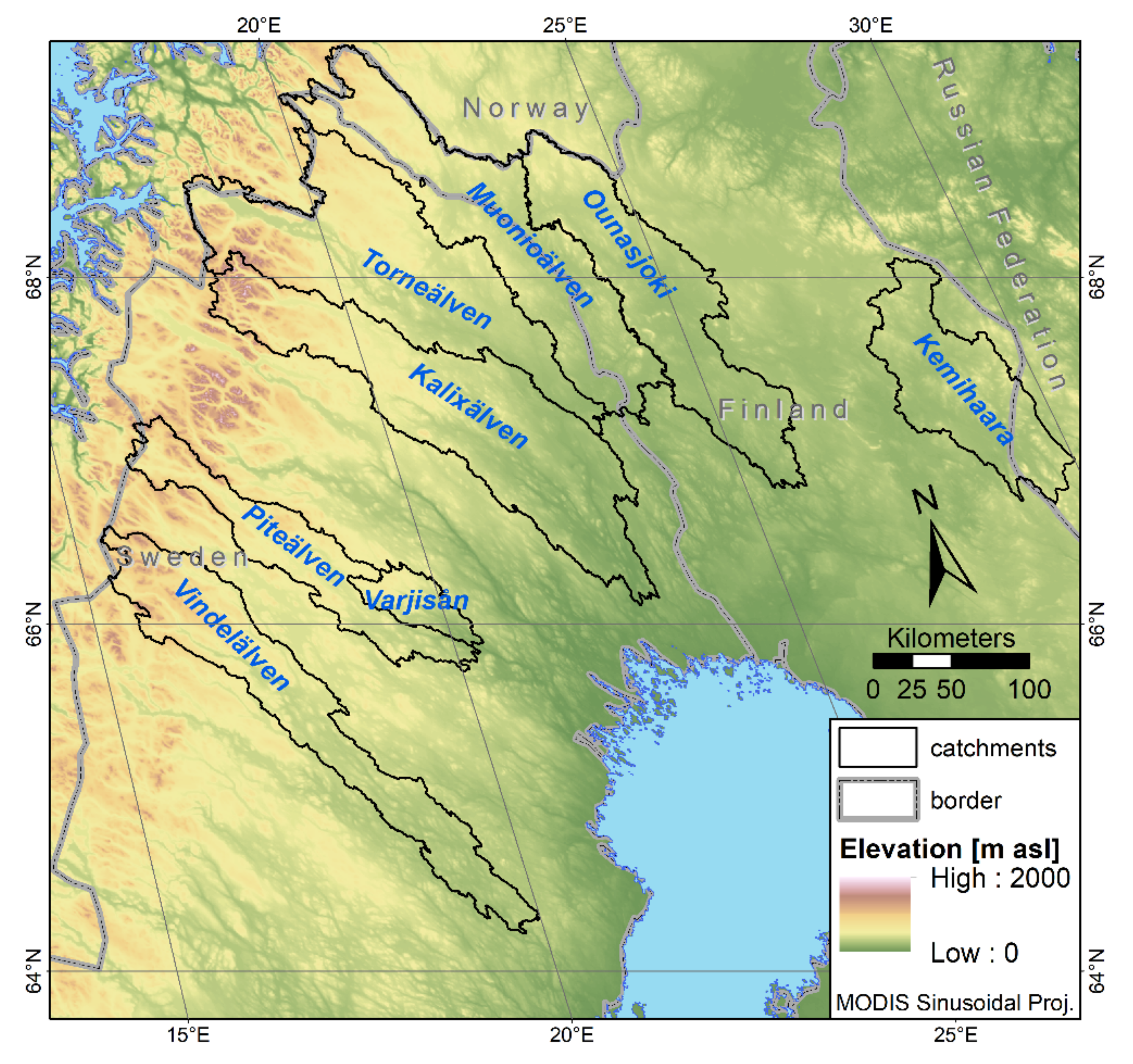
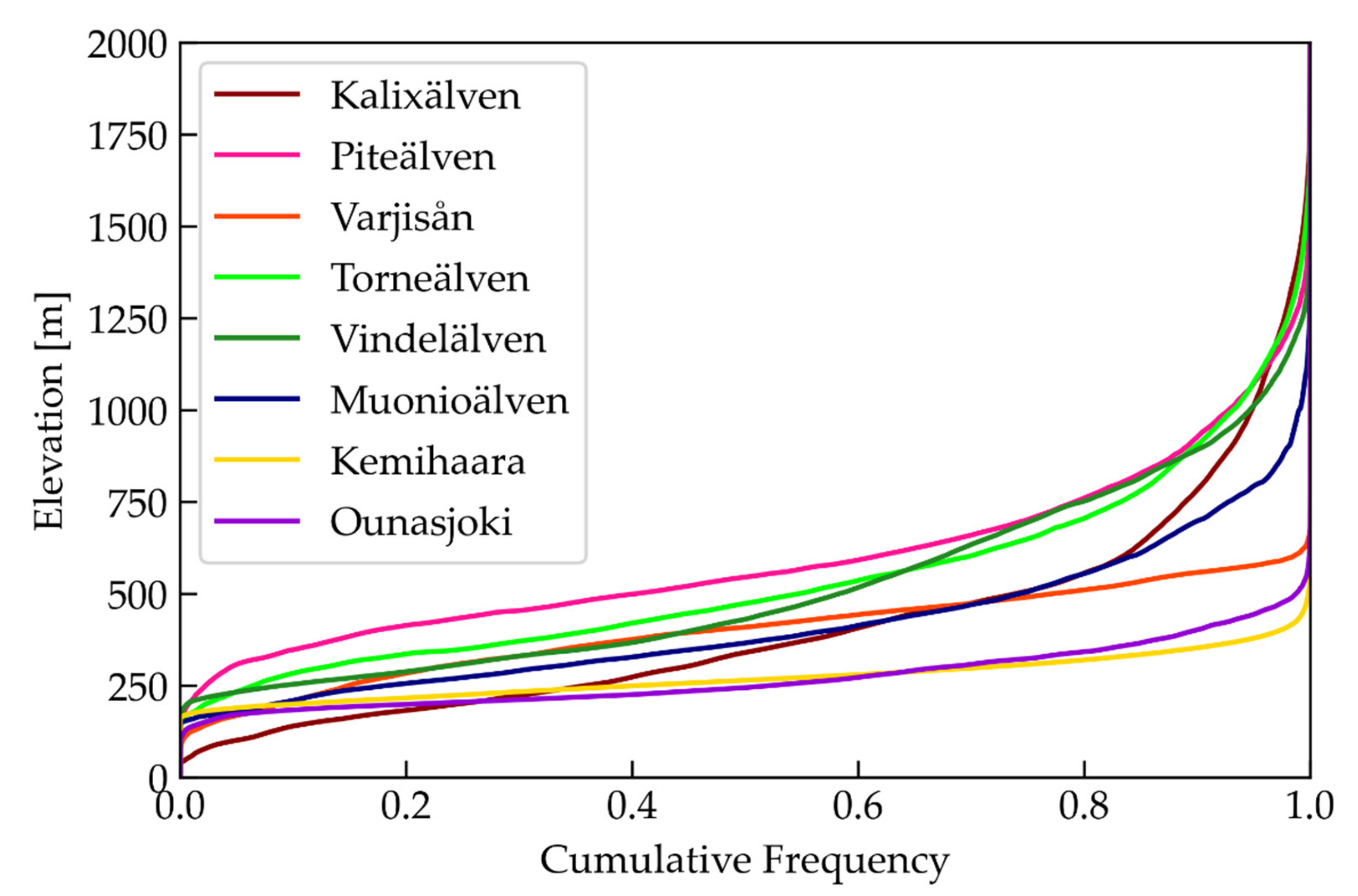
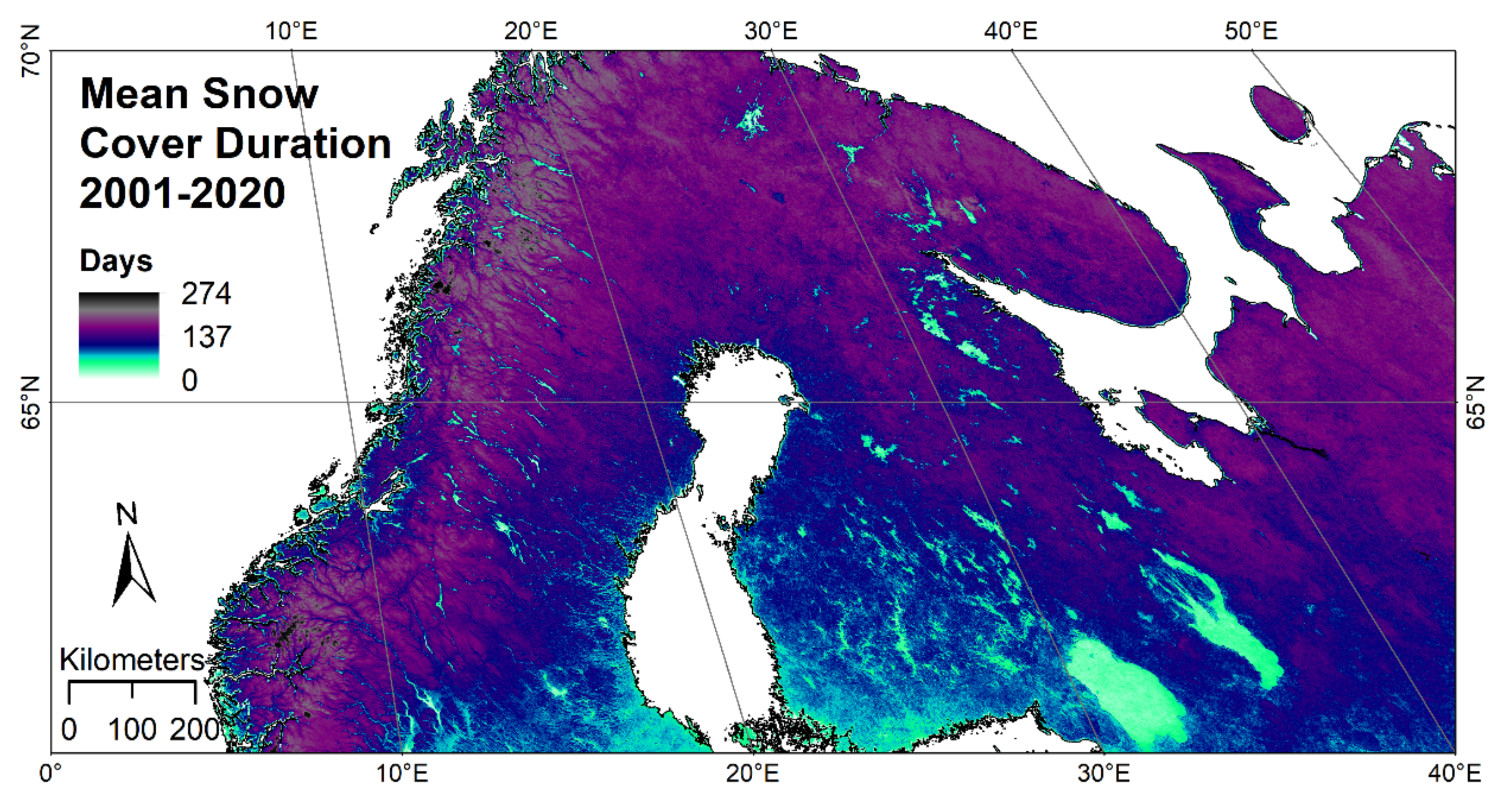

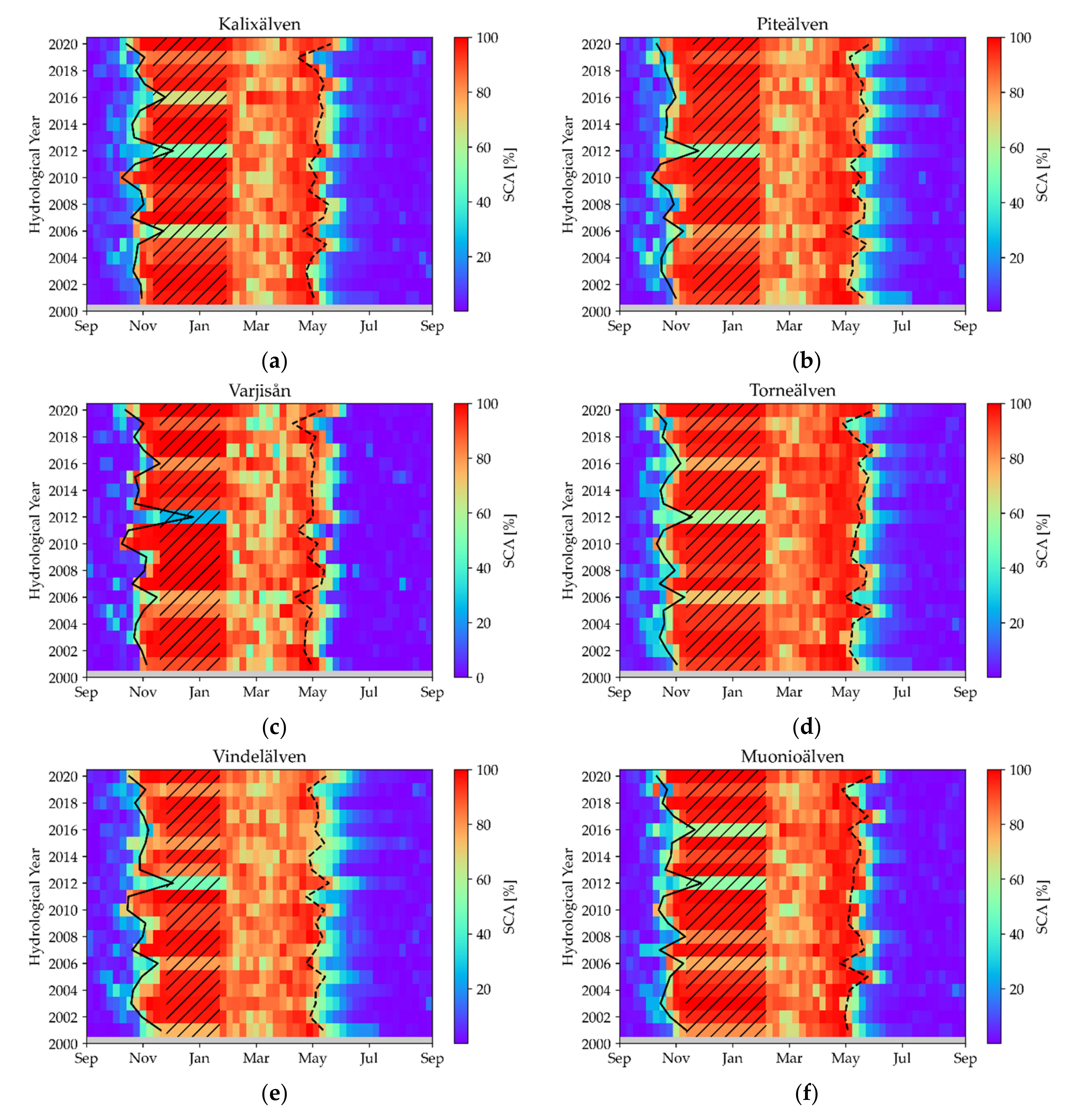
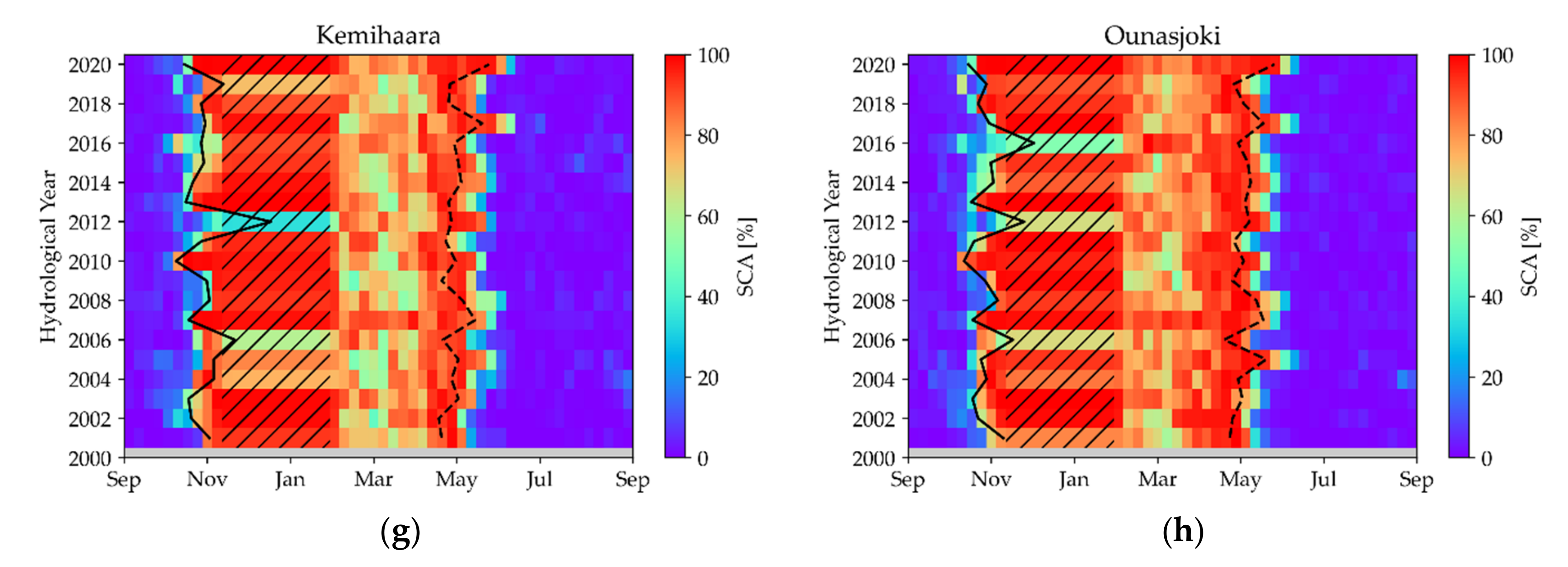
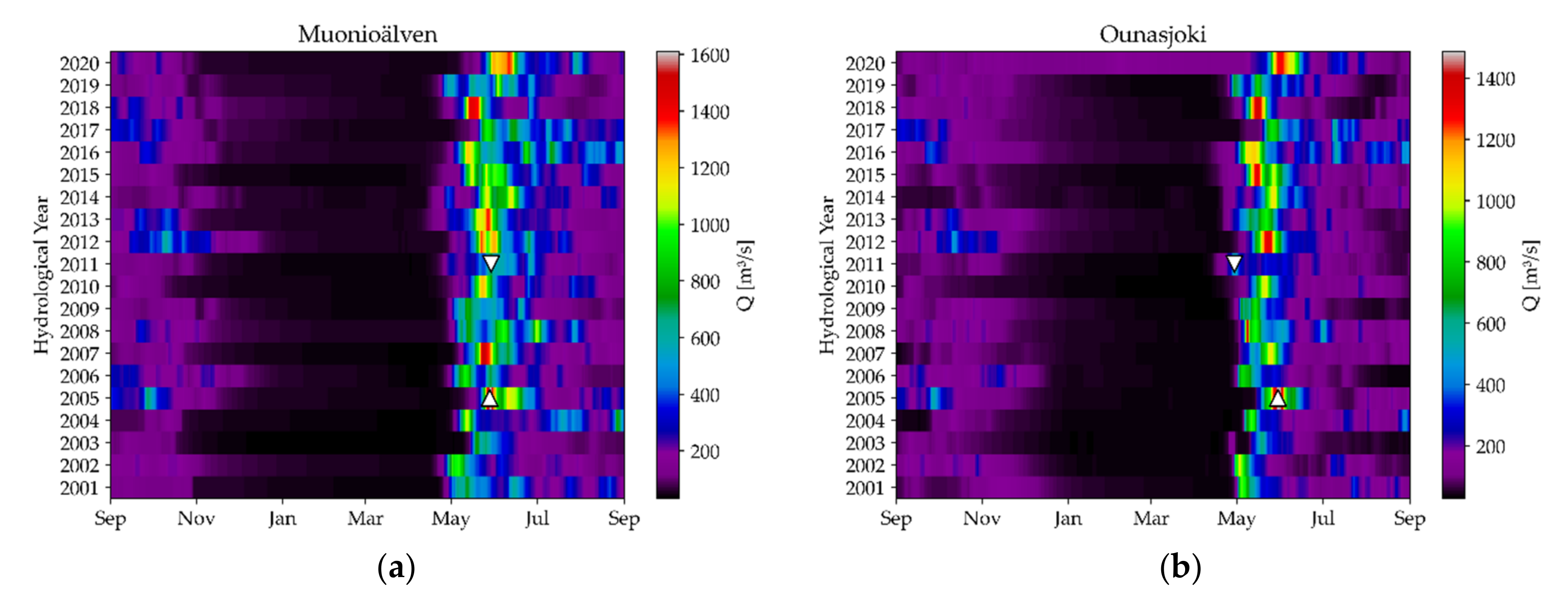

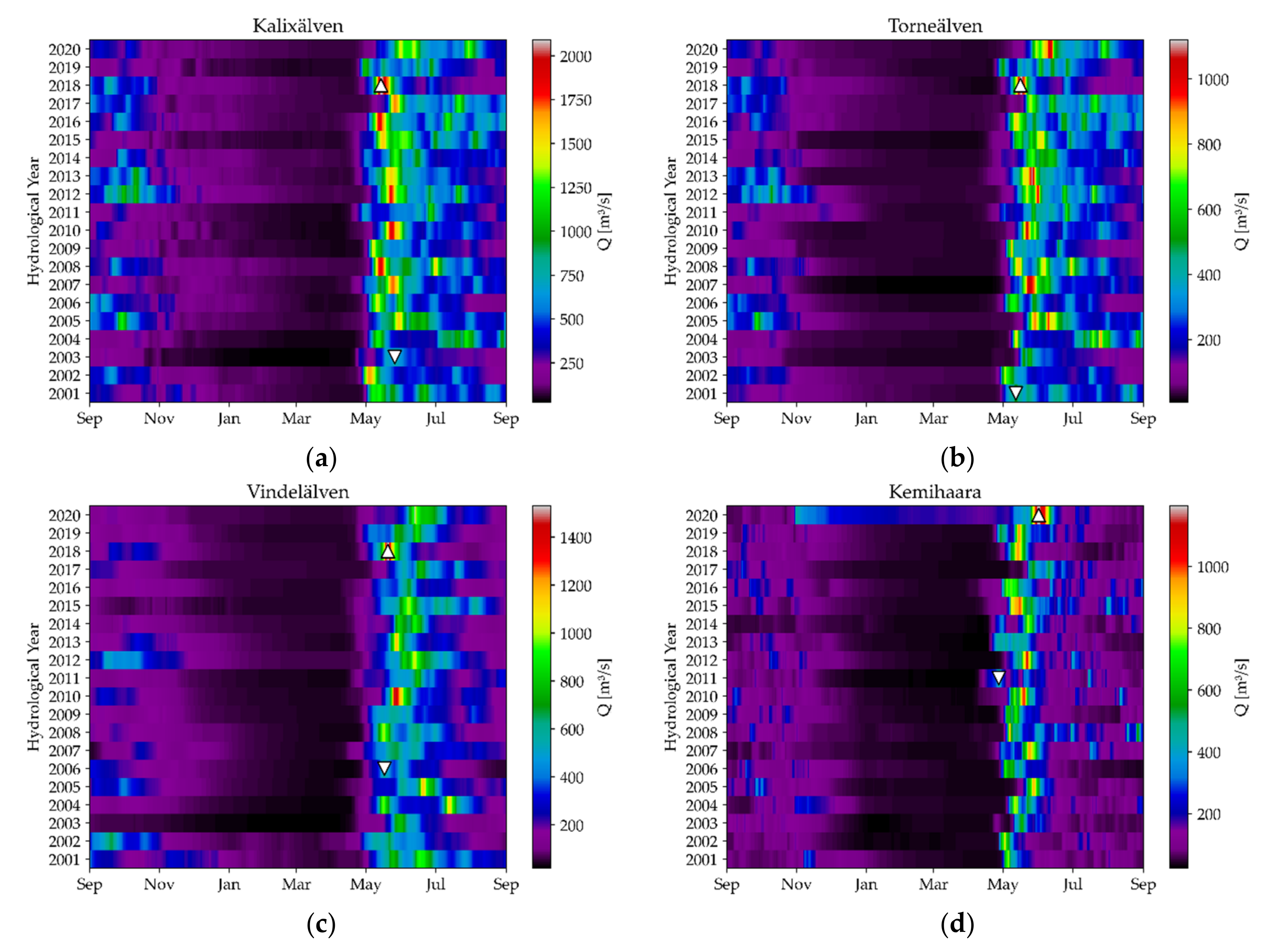
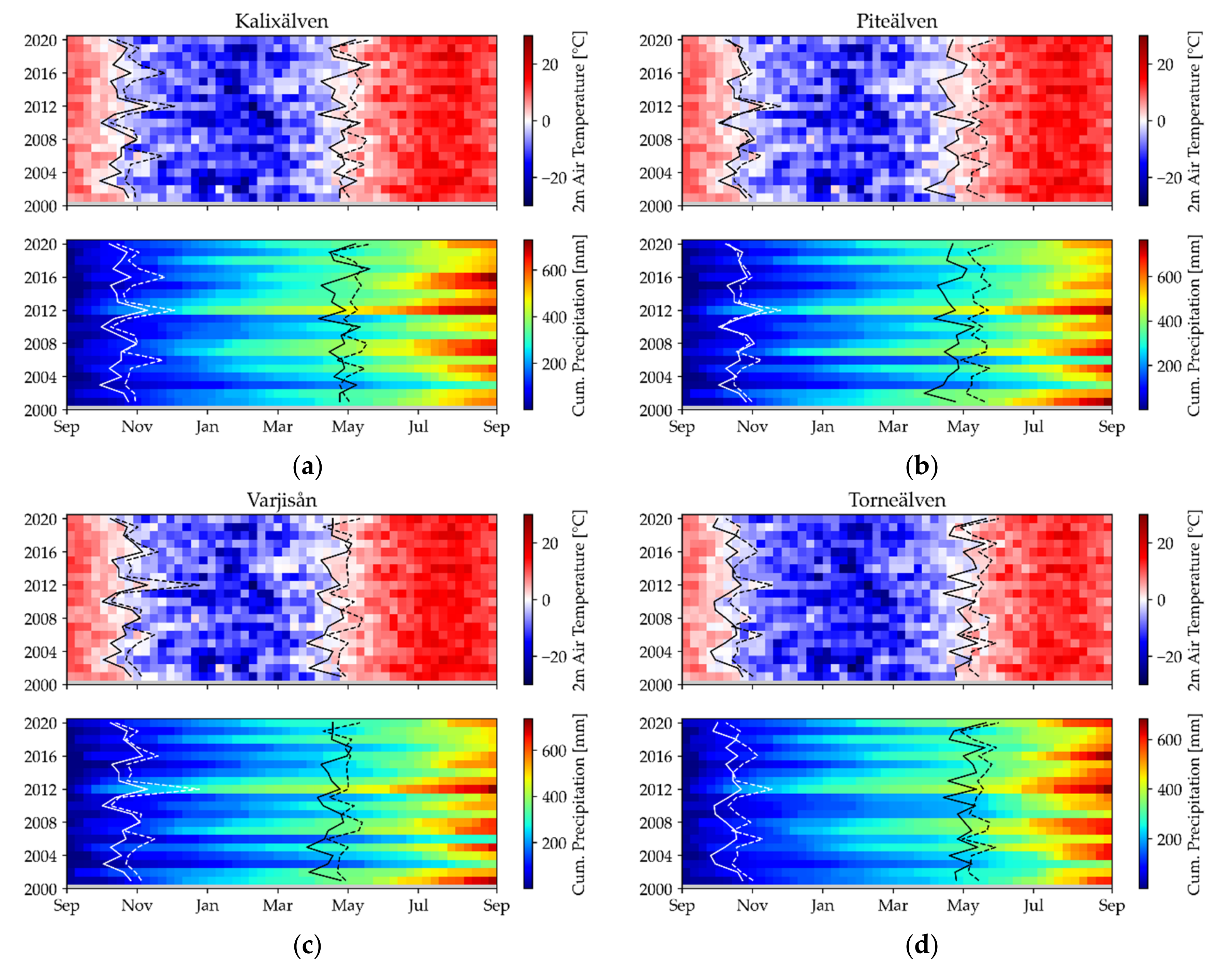

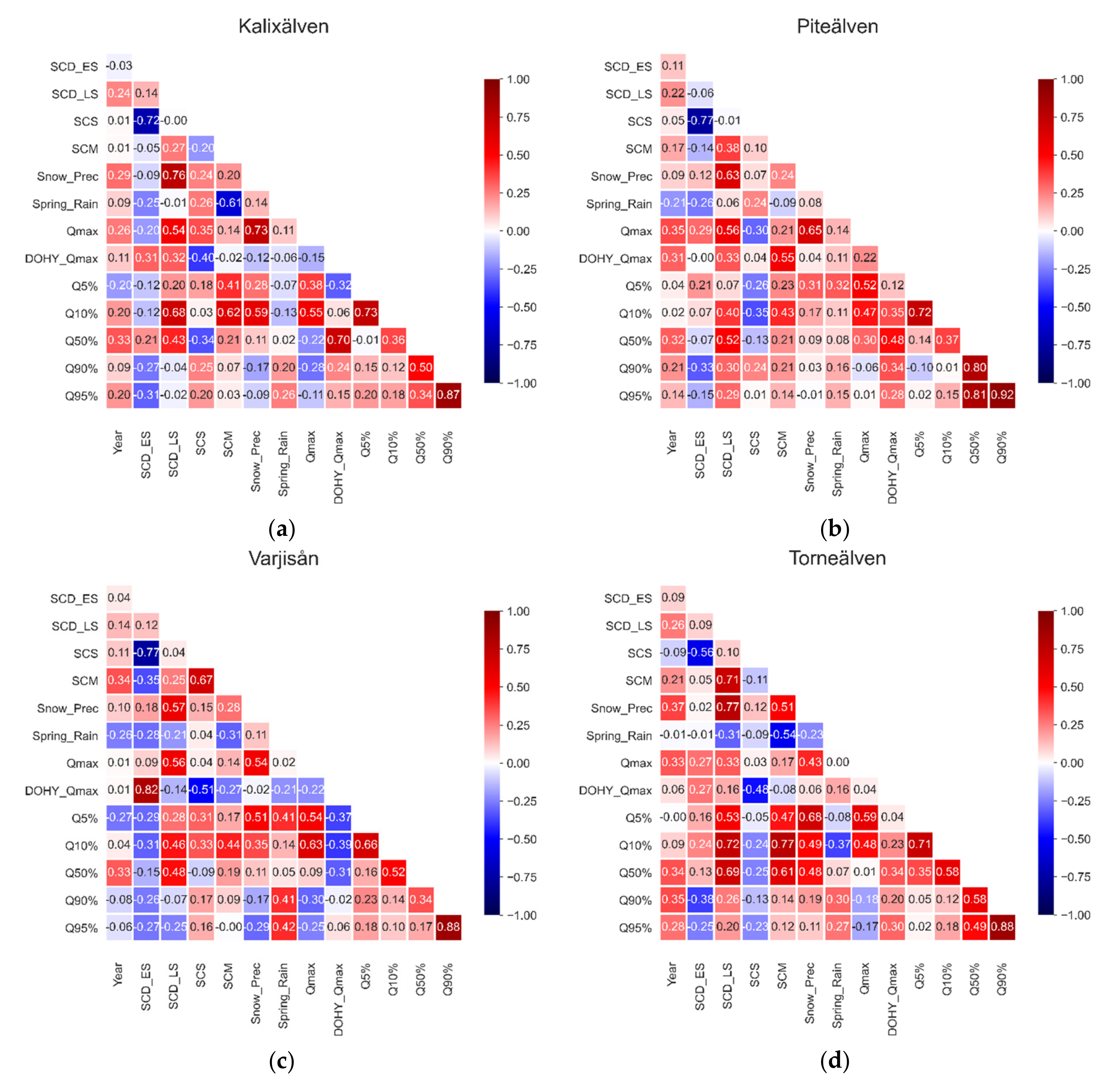
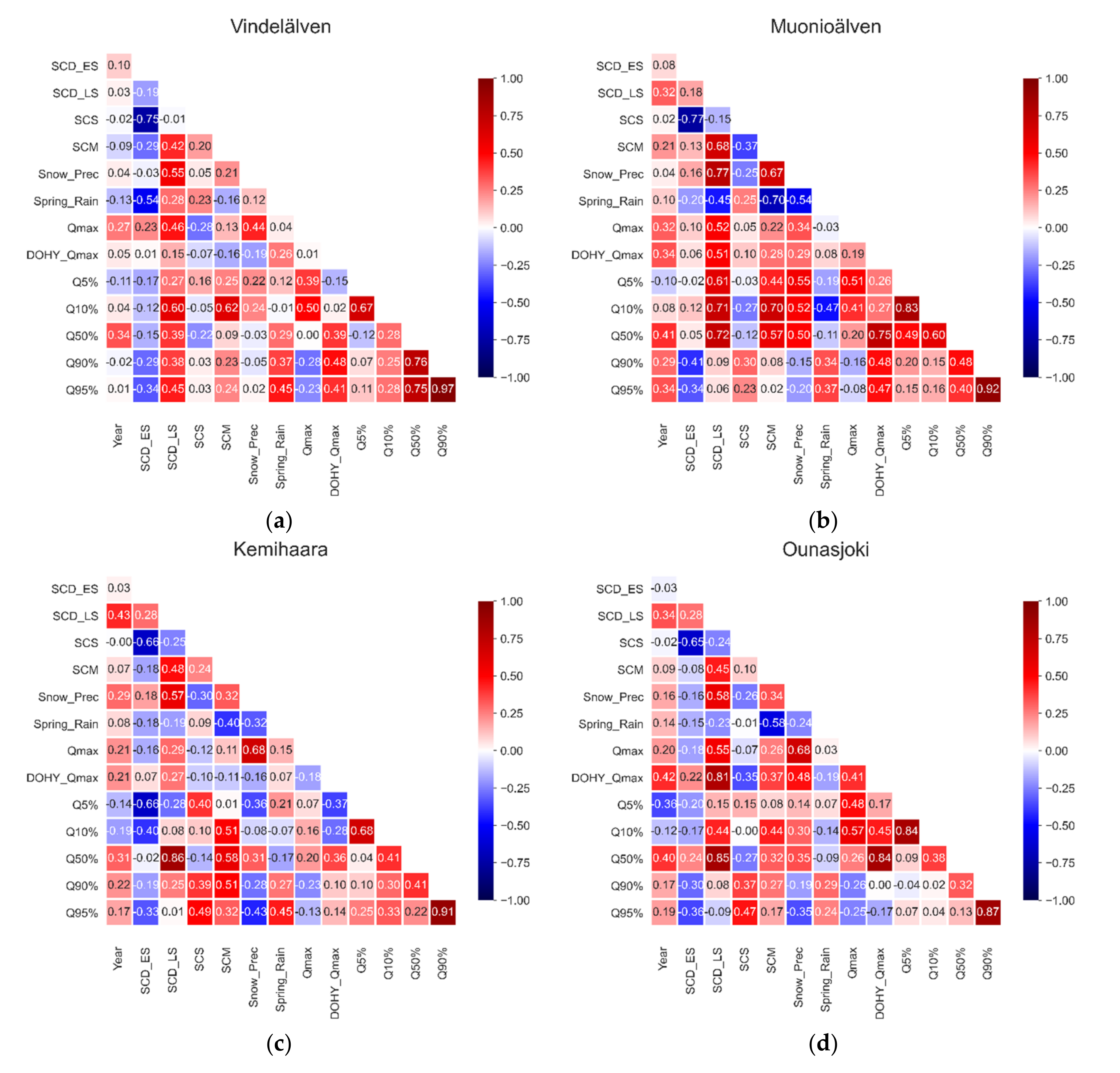
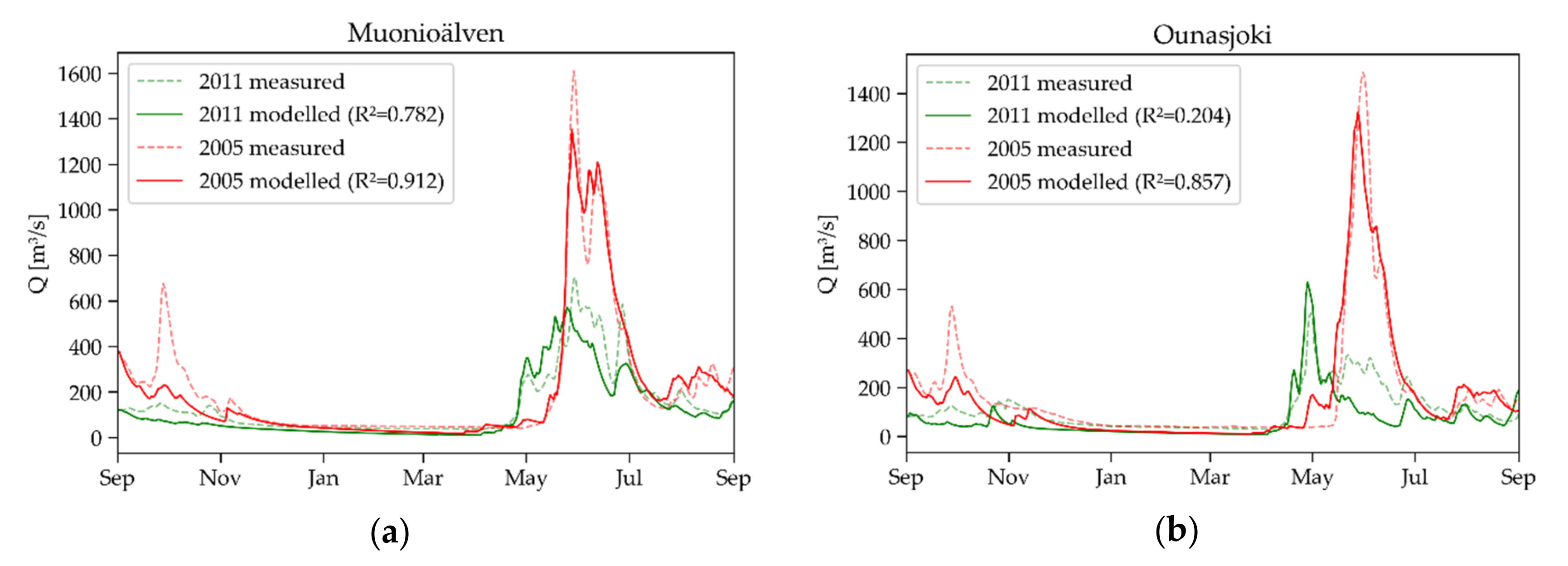
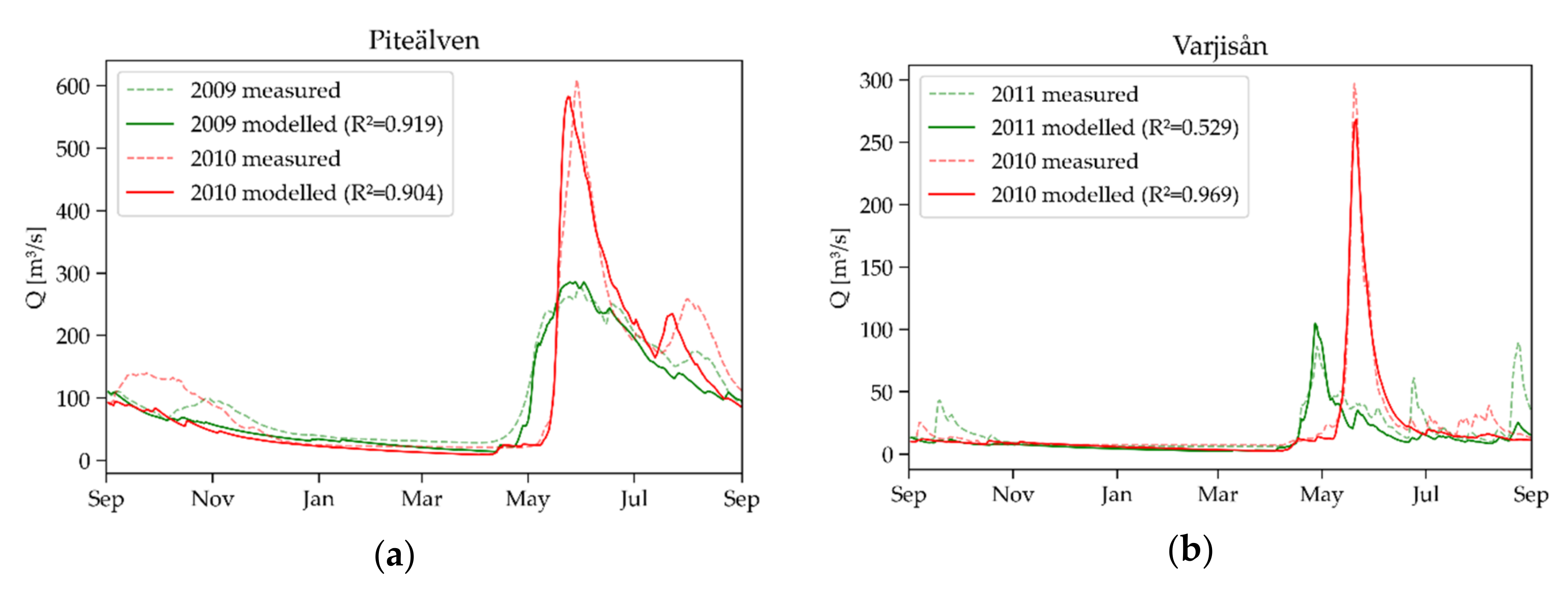
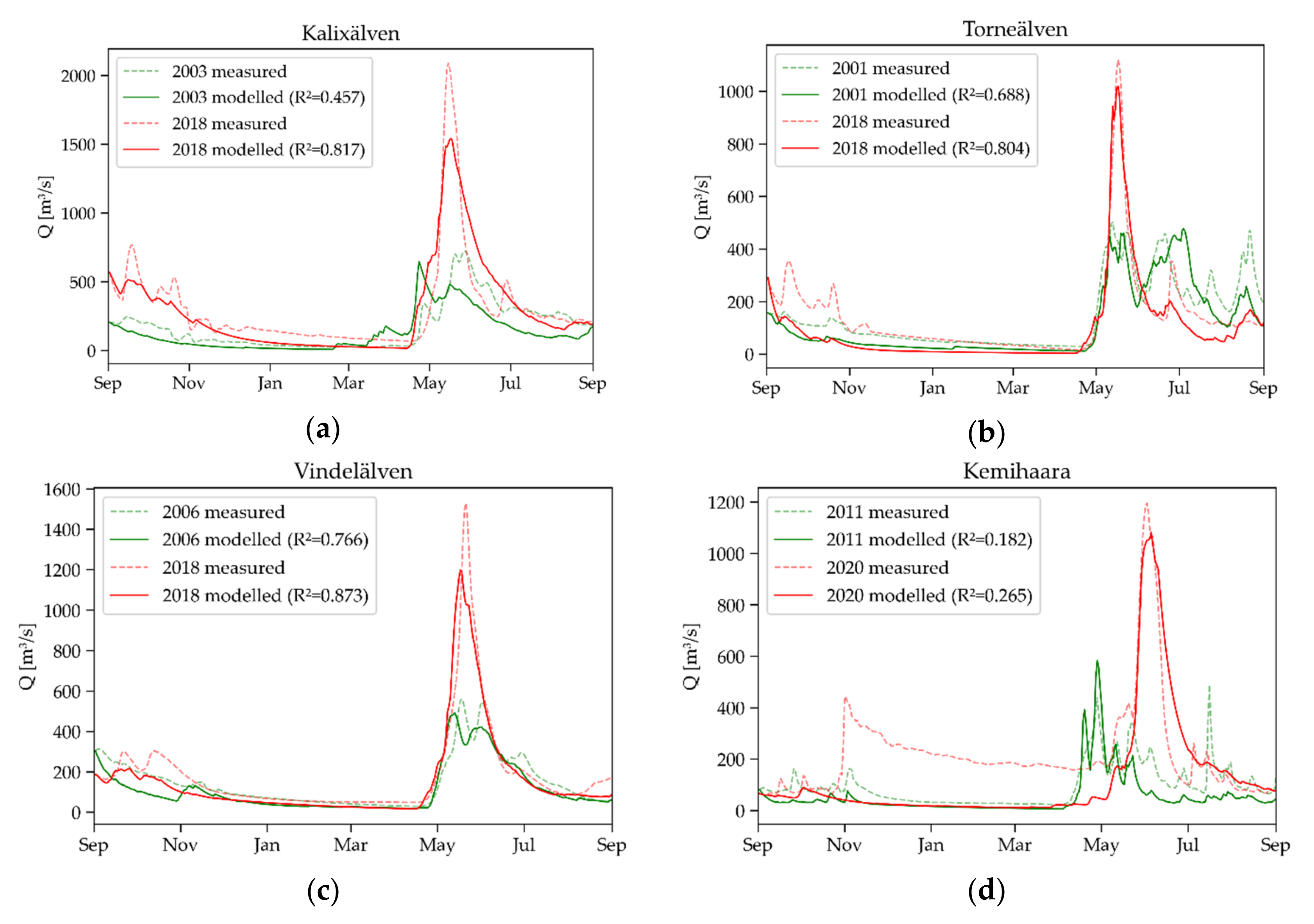
| River | Basin ID | Country | Area [km2] | Elevation [m MSL] | ||
|---|---|---|---|---|---|---|
| Min | Max | Mean | ||||
| Kalixälven | 0017 | SE | 23,102.9 | 41 | 1962 | 406.1 |
| Piteälven | 1387 | SE | 6930.9 | 129 | 1634 | 593.8 |
| Varjisån | 1706 | SE | 1908.4 | 78 | 679 | 396.0 |
| Torneälven | 2012 | SE | 11,038.1 | 154 | 1828 | 536.4 |
| Vindelälven | 2237 | SE | 11,846.4 | 162 | 1531 | 515.0 |
| Muonioälven | 2395 | SE/FI | 14,477.1 | 140 | 1471 | 412.6 |
| Kemihaara | 6501700 | FI | 8464.2 | 157 | 617 | 270.8 |
| Ounasjoki | 6503600 | FI | 11,660.0 | 102 | 746 | 270.7 |
| Abbreviation | Unit | Description | Source |
|---|---|---|---|
| Year | Year | Hydrological Year | - |
| SCDES | Days | Early Season Snow Cover Duration | Global SnowPack |
| SCDLS | Days | Late Season Snow Cover Duration | Global SnowPack |
| SCS | DOHY 1 | Snow cover start derived from daily mean air temperature | Meteorology |
| SCM | DOHY | Snow cover melt derived from daily mean air temperature | Meteorology |
| Snow_Prec | mm | Cum. sum of (solid) precipitation between SCS and SCM | Meteorology |
| Spring_Rain | mm | Cum. sum of precipitation between SCM and 30 June | Meteorology |
| Qmax | m3/s | Peak discharge | Hydrology |
| DOHY_Qmax | DOHY | Time of peak discharge | Hydrology |
| Q5% | DOHY | Time where 5% of the cum. discharge occur | Hydrology |
| Q10% | DOHY | Time where 10% of the cum. discharge occur | Hydrology |
| Q50% | DOHY | Time where 50% of the cum. discharge occur | Hydrology |
| Q90% | DOHY | Time where 90% of the cum. discharge occur | Hydrology |
| Q95% | DOHY | Time where 95% of the cum. discharge occur | Hydrology |
| Parameter | Unit | Kalixälven | Piteälven | Varjisån | Torneälven | Vindelälven | Mounioälven | Kemihaara | Ounasjoki |
|---|---|---|---|---|---|---|---|---|---|
| SCDES | days/year | 0 | 0.29 | 0.18 | 0.2 | 0 | 0.21 | 0.24 | 0.16 |
| SCDLS | days/year | 0.56 * | 0.24 | 0.45 * | 0.63 * | 0.03 | 0.52 ** | 0.5 * | 0.56 * |
| SCS | days/year | −0.29 | 0 | 0.11 | −0.17 | 0 | −0.1 | 0 | −0.11 |
| SCM | days/year | 0 | 0.25 | 0.5 * | 0.46 | 0 | 0.41 | 0.03 | 0.16 |
| Snow_Prec | mm/year | 1.88 * | 2 | 2.59 | 2.21 * | 1.58 | −0.6 | 0.81 | 0.33 |
| Spring_Rain | mm/year | 1.25 | −0.87 | −1.17 | −0.06 | −0.85 | 1.67 * | 0.36 | 1.94 * |
| Qmax | (m2/s)/year | 0.09 | 0.22 ** | −0.08 | 0.06 * | 0.07 * | 0.1 * | 0.11 * | 0.06 |
| DOHY_Qmax | days/year | 0.21 | 0.15 | 0.52 * | 0.81 * | 0.33 | 0.84 ** | 0.61 * | 0.71 ** |
| Q5% | days/year | −0.07 | 0.08 | −0.11 | 0 | −0.13 | 0 | 0 | −0.25 * |
| Q10% | days/year | 0.14 | 0 | 0 | 0.13 | −0.03 | 0 | −0.16 | −0.1 |
| Q50% | days/year | 0.31 * | 0.31 * | 0.25 * | 0.43 * | 0.47 * | 0.5 ** | 0.26 * | 0.5 * |
| Q90% | days/year | 0 | 0 | −0.08 | 0.12 * | 0.07 | 0.13 | 0.17 * | 0.07 |
| Q95% | days/year | 0 | 0 | 0 | 0* | 0 | 0.09 * | 0.09 | 0.12 * |
| Type | Year | Rivers | SCDES/SCS | SCDLS/SCM | Snow Precipitation | Remarks |
|---|---|---|---|---|---|---|
| 1 | 2005 | Muonioälven, Ounasjoki | Normal | 2 weeks later | 35% higher | - |
| 2 | 2010 | Piteälven, Varjisån | 3 weeks earlier | Normal | 20% higher | - |
| 3 | 2018 | Kalixälven, Torneälven, Vindelälven | 1 week earlier | Normal | Normal (up to 10% higher) | A drastic increase in air temperature led to very rapid melting |
| 4 | 2020 | Kemihaara | 2 weeks earlier | 3 weeks later | 60% higher | - |
Publisher’s Note: MDPI stays neutral with regard to jurisdictional claims in published maps and institutional affiliations. |
© 2021 by the authors. Licensee MDPI, Basel, Switzerland. This article is an open access article distributed under the terms and conditions of the Creative Commons Attribution (CC BY) license (http://creativecommons.org/licenses/by/4.0/).
Share and Cite
Rößler, S.; Witt, M.S.; Ikonen, J.; Brown, I.A.; Dietz, A.J. Remote Sensing of Snow Cover Variability and Its Influence on the Runoff of Sápmi’s Rivers. Geosciences 2021, 11, 130. https://doi.org/10.3390/geosciences11030130
Rößler S, Witt MS, Ikonen J, Brown IA, Dietz AJ. Remote Sensing of Snow Cover Variability and Its Influence on the Runoff of Sápmi’s Rivers. Geosciences. 2021; 11(3):130. https://doi.org/10.3390/geosciences11030130
Chicago/Turabian StyleRößler, Sebastian, Marius S. Witt, Jaakko Ikonen, Ian A. Brown, and Andreas J. Dietz. 2021. "Remote Sensing of Snow Cover Variability and Its Influence on the Runoff of Sápmi’s Rivers" Geosciences 11, no. 3: 130. https://doi.org/10.3390/geosciences11030130
APA StyleRößler, S., Witt, M. S., Ikonen, J., Brown, I. A., & Dietz, A. J. (2021). Remote Sensing of Snow Cover Variability and Its Influence on the Runoff of Sápmi’s Rivers. Geosciences, 11(3), 130. https://doi.org/10.3390/geosciences11030130







